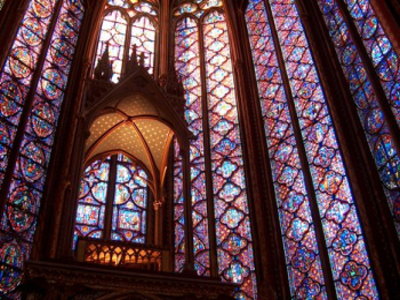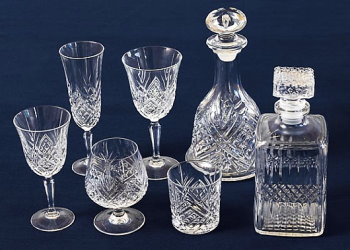Glassmaking
Explain how Europe benefited from cultural diffusion during the period c. A.D. 1000 - 1500.
Origin
Glass appears to have been produced as far back as the second millennium B.C. by the Egyptians and perhaps the Phoenicians. It is assumed to originate in Mesopotamia, where pieces of well made glass have been found, believed to date from the third millennium B.C.
The art of glass making eventually reached Egypt. The Egyptians used a method called core-forming. A shaped core was made of clay and dung, then molten glass was wrapped around it and shaped by rolling it on a smooth surface.
After the decline of the Roman Empire in the 4th & 5th centuries A.D., the craft of glass making waned in Europe. The industry continued to thrive in Iran, Iraq & Egypt. In Europe, there was a limited revival of glass making in the early 12th Century, with the development of stained glass windows for cathedrals & monasteries.

Medieval glass at Sainte-Chapelle, Paris.
The 11th century also saw the development of a technique to create sheet glass.
By blowing a hollow glass sphere and swinging it vertically, gravity would pull the glass into a cylindrical
bubble
. While still hot, the ends of the bubble were cut off and the resulting cylinder cut lengthways and laid flat.
The resulting glass panes thus created would then be joined with lead strips and pieced together to create windows.
Glass remained, however, a great luxury up to the late Middle Ages, with royal palaces and churches the most likely buildings to have glass windows. Stained glass windows reached their peak as the Middle Ages drew to a close, with an increasing number of public buildings, inns and the homes of the wealthy fitted with clear or colored glass decorated with historical scenes and coats of arms.
Venice
A flourishing glass industry did not develop in Europe until the end of the 13th Century, when Venice became a major glass making center. They learned their glass making techniques through their contacts during the Crusades. The Venetians provided the link between the ancient & modern glass making arts. Venetian glass was noted for its brilliance & for its light, imaginative forms.
The importance of the glass industry in Venice can be seen by more than 8,000 craftsmen at work there at one point. A 1271 ordinance, a type of glass sector statute, laid down certain protectionist measures such as a ban on imports of foreign glass and a ban on foreign glassmakers who wished to work in Venice: non-Venetian craftsmen were themselves clearly sufficiently skilled to pose a threat.
Until the end of the 13th century, most glassmaking in Venice took place in the city itself. However, the frequent fires caused by the furnaces led the city authorities, in 1291, to order the transfer of glassmaking to the island of Murano. So highly esteemed were the Venetian glass makers, that they were forbidden to leave the Island of Murano, lest their precious trade secrets be imparted to others.

Lead Crystal Glass
In the 14th century, another important Italian glassmaking industry developed at Altare, near Genoa. Its importance lies largely in the fact that it was not subject to the strict statutes of Venice as regards the exporting of glass working skills. Thus, during the 16th century, craftsmen from Altare helped extend the new styles and techniques of Italian glass to other parts of Europe, particularly France.
However, it was to be another two centuries later that in 1676, an Englishman named George Ravenscroft made a discovery. Adding lead oxide to the glass composition produced a far more brilliant, sparkling glass. Lead crystal has now been born.
